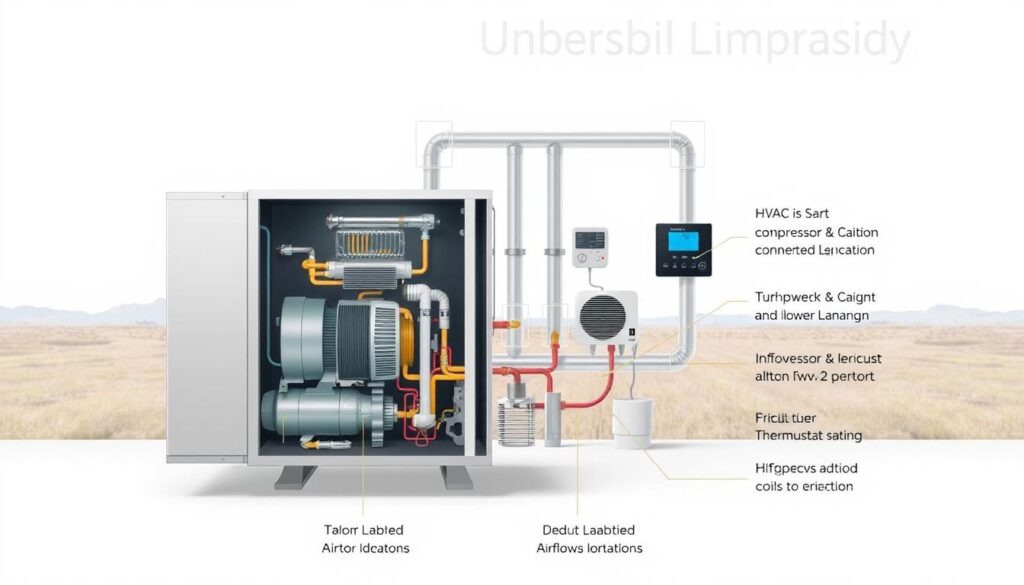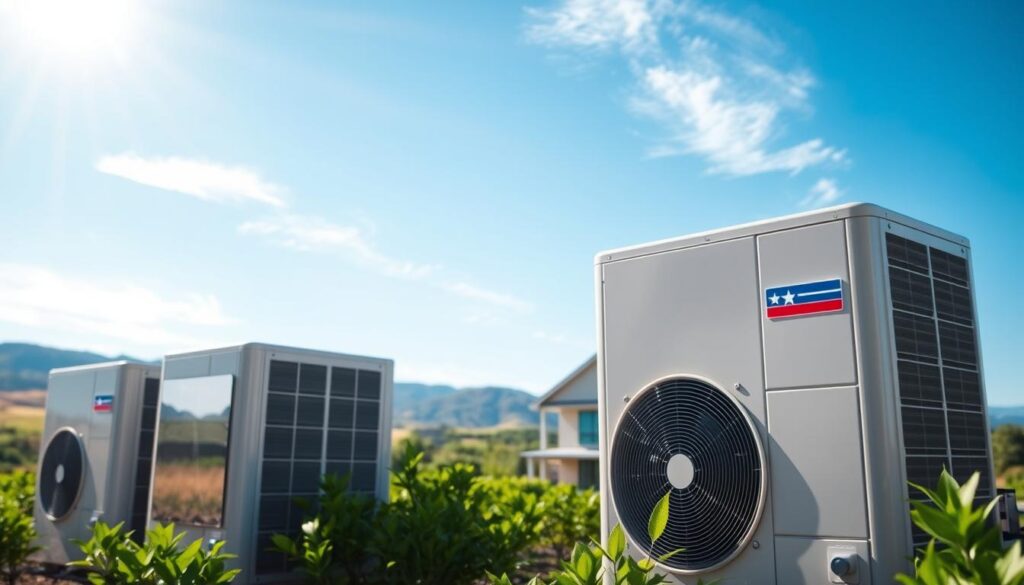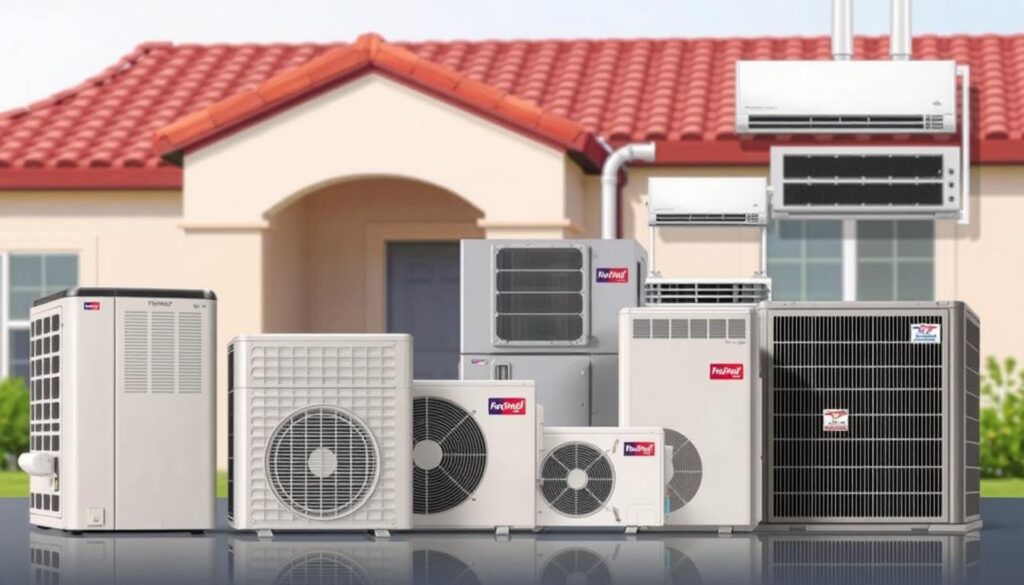Affiliate Disclosure
HVAC Guide Guys is a participant in the Amazon Services LLC Associates Program, an affiliate advertising program designed to provide a means for sites to earn advertising fees by advertising and linking to Amazon.
How Long Do HVAC Systems Last in Texas? Ever wondered why your neighbor’s air conditioning works well in Texas summers? Yours might not? It’s because they know how long HVAC systems last here and how to keep them going.

In Texas, HVAC systems usually last 10 to 15 years. But, with regular care, they can last even longer. Texas’s hot weather is tough on these systems, so getting them checked often is key.
The Texas climate is hard on HVAC systems. Summers over 100°F can make them wear out faster. It’s important for homeowners to know how to keep their systems running well.
Key Takeaways
- Texas HVAC systems typically last 10-15 years
- Extreme heat dramatically impacts system performance
- Regular maintenance can extend system life
- Professional installation is critical for longevity
- Annual professional checkups are recommended
Table of Contents
Understanding HVAC System Lifespan in Texas Climate
Living in Texas means your HVAC system faces unique challenges. The intense heat and humidity can significantly impact ac longevity in texas, putting extra strain on your cooling equipment throughout the year.
Your HVAC units durability in the Texas climate depends on several critical factors. The extreme temperatures and constant usage can accelerate wear and tear more quickly than in milder regions.
Average Life Expectancy for Different HVAC Systems
The lifespan of HVAC systems varies depending on the type and maintenance:
- Central Air Conditioning Units: 15 to 20 years
- Window AC Units: 10 to 15 years
- Heat Pumps: 10 to 15 years
- Ductless Mini-Split Systems: 10 to 30 years
Impact of Texas Weather on System Durability
Texas summers are brutal on HVAC systems. The prolonged heat means your air conditioner works overtime, potentially reducing its expected lifespan. Coastal areas experience additional challenges from salt air, while desert regions face extreme dry conditions that can stress mechanical components.
Regional Variations Across Texas
Different Texas regions present unique challenges for HVAC systems:
- Coastal regions: Salt air increases corrosion risks
- Desert areas: Extreme dry heat causes additional wear
- Urban centers: Higher pollution and dust can impact system performance
Proactive maintenance can help extend your HVAC system’s life, regardless of your specific Texas location. Annual professional inspections and regular filter changes are key for maximizing durability and efficiency.
Explore Our HVAC Shop
Looking for top-rated HVAC tools, parts, and accessories? Visit our shop and find the perfect solution for your needs.
Visit the ShopFactors Affecting HVAC System Longevity
Knowing what affects your HVAC system’s life is key for Texas homeowners. The time you’ll need to replace your HVAC depends on several important factors. These factors can greatly affect how long your system keeps your home comfortable.
Your HVAC system’s average life in Texas isn’t just about the equipment. Many elements work together to determine how long your system will run well.
Quality of Installation
Professional installation is vital for your HVAC system’s long life. Bad installation can cause:
- Lower system efficiency
- More energy use
- Sooner system failure
- More repairs
Usage Patterns Matter
How you use your HVAC system affects its lifespan. Texas’ hot and cold weather is tough on cooling systems.
- High demand strains the system
- Constant use wears it down faster
- Thermostat settings affect performance
Maintenance Frequency
Regular maintenance is the most critical factor in extending your HVAC system’s life. Getting your system serviced annually can add years to its life.
A well-maintained HVAC system can last up to 15-20 years, compared to 10-12 years for poorly maintained units.
By understanding and managing these factors, Texas homeowners can make their HVAC systems last longer. This saves money and keeps your home comfortable.
Signs Your HVAC System Needs Replacement
Living in Texas means your HVAC system works hard all year. Knowing when it needs a new one can save you money. It also helps avoid breakdowns when it’s hottest outside.
The age of your HVAC system in Texas affects how well it works. Air conditioning units usually last 10 to 12 years. But, the hot Texas weather can make them wear out faster.
- Skyrocketing Energy Bills: A sudden 20% increase in electricity costs signals your AC might be dying
- Frequent Repairs: Constant maintenance suggests it’s time for a new system
- Inconsistent Temperatures: Uneven cooling indicates declining system efficiency
- Unusual Noises: Banging, squealing, or grinding sounds are red flags
“When repair costs approach 50% of a new unit’s price, replacement becomes the smart financial decision.” – HVAC Expert
Think about the $5,000 rule. Multiply your system’s age by repair costs. If it’s over $5,000, getting a new HVAC system is a good choice.
| System Age | Replacement Indicators |
|---|---|
| 10-12 years | High probability of replacement needed |
| 15+ years | Urgent replacement recommended |
| Constant Repairs | Strong sign of system failure |
Replacing your HVAC system early can make your home more comfortable. It also cuts down on energy use. Plus, it stops unexpected breakdowns during Texas’s hottest times.
Explore Our HVAC Shop
Looking for top-rated HVAC tools, parts, and accessories? Visit our shop and find the perfect solution for your needs.
Visit the ShopThe Impact of Proper Installation on System Lifespan
Proper installation is key for your air conditioning system’s life in Texas. The setup’s quality greatly affects its performance and how long it lasts.
For your HVAC system to last longer in Texas, professional installation is vital. A bad installation can make your system less efficient and shorter-lived.
Professional Installation Requirements
Choosing a certified HVAC contractor is critical for your system’s best performance. Look for professionals with:
- State-certified HVAC technicians
- Proven track record of installations
- Updated industry certifications
- Comprehensive insurance coverage
Sizing Considerations
Getting the right system size is essential for your HVAC’s longevity. The wrong size can cause:
- High energy use
- Sooner system wear
- Unstable home temperature
- Higher utility bills
Installation Best Practices
Following best practices during installation can add years to your system’s life. Precision matters in every step, from ductwork to refrigerant charging.
A well-installed HVAC system can last between 15-20 years with proper maintenance.
Professional installation might cost more at first, but it saves you from future $500 problems. It also keeps your system running efficiently for years.
Maintenance Tips to Extend HVAC Life in Texas
Protecting your HVAC system in Texas needs careful maintenance. The harsh climate requires proactive care to extend your system’s life. Regular maintenance can greatly extend your system’s lifespan and prevent expensive breakdowns.
Here are some key maintenance tips for a longer HVAC life in Texas:
- Change air filters every 1-3 months to keep airflow optimal
- Schedule professional inspections twice a year
- Clean outdoor units regularly to remove debris
- Check and seal air ducts to prevent energy loss
- Monitor humidity levels to reduce system strain
Texas homeowners should focus on preventive maintenance. Routine care can cut heating and cooling costs by up to 30%. With the right care, your HVAC system can last 10-20 years, avoiding early replacement.
Consider these extra strategies:
- Use ceiling fans to lessen HVAC workload
- Set thermostat fan to “AUTO” mode
- Maintain consistent temperature settings
- Inspect drain lines annually
By investing in regular maintenance, you’ll shield your HVAC system from Texas’s tough climate. This ensures efficient, long-lasting performance.
Energy Efficiency and System Duration
Understanding how energy efficiency affects ac longevity in Texas is key. Modern air conditioning has changed how we cool our homes. It also impacts how long our systems last.

The Seasonal Energy Efficiency Ratio (SEER) rating is important for your HVAC system’s lifespan in Texas. A higher SEER rating means your system saves more energy. This can greatly improve its performance over time.
SEER Ratings Explained
SEER ratings show how well an air conditioner cools compared to its energy use. Here’s what you need to know:
- Higher SEER ratings mean better energy efficiency
- Modern systems range from 13 to 25 SEER
- Older systems typically have ratings between 8-10 SEER
Cost-Saving Benefits
Choosing a high-efficiency HVAC system can save you money:
- Lower monthly energy bills
- Potential tax credits and rebates
- Less environmental impact
- Longer system lifespan
Pro tip: Systems with SEER ratings of 16 or higher can reduce energy consumption by up to 50% compared to older models.
Energy-efficient systems save money and help the environment in Texas’s climate.
Explore Our HVAC Shop
Looking for top-rated HVAC tools, parts, and accessories? Visit our shop and find the perfect solution for your needs.
Visit the ShopCommon HVAC Problems in Texas Climate
The Texas heat is tough on HVAC units, affecting their lifespan and performance. Knowing these common issues can help keep your cooling system running well.
Dirt on air filters is a big problem in Texas’s dry air. These filters catch dust, pollen, and dirt, blocking airflow and stressing your system. It’s best to change filters every 30-90 days for the best results.
- Refrigerant leaks reduce cooling capacity
- Poor indoor air quality from accumulated dust
- Increased energy consumption
- Potential environmental damage from refrigerant emissions
Summer temperatures in Texas can hit over 100 degrees, putting a lot of stress on HVAC units. The high humidity makes air conditioning work even harder, leading to:
- Condensation buildup
- Coil corrosion
- Reduced system efficiency
- Premature component wear
Keeping your HVAC system in good shape in Texas depends on regular maintenance. Look out for signs like strange noises, uneven temperatures, or high electric bills. These could mean there’s a problem that could shorten your system’s life.
Pro tip: Make sure there’s at least two feet of space around your outdoor AC unit. Also, think about getting a programmable thermostat to save energy and reduce strain on your system.
Understanding Different HVAC Types and Their Durability

In Texas, homeowners face a variety of HVAC options. The state’s climate is tough, requiring strong HVAC units. These units must handle extreme temperatures and changing weather.
Now, let’s look at the main HVAC types and how they hold up in Texas:
- Central Air Conditioning Systems
- Typical lifespan: 15-20 years
- Most common in Texas homes
- Best for consistent cooling across larger spaces
- Heat Pumps
- Provides both heating and cooling
- More efficient in milder Texas regions
- Average lifespan: 10-15 years
- Ductless Mini-Split Systems
- Ideal for targeted cooling
- Great for homes with zone control needs
- Typically last 10-12 years
The durability of your HVAC units in Texas depends on a few key things. Regular upkeep, correct installation, and picking the right system for your home are all important. These steps can help your HVAC last longer.
Pro Tip: Zone control systems can reduce overall energy usage. This can help your HVAC equipment last longer by not running all the time.
When picking an HVAC system in Texas, think about your home’s size, the local climate, and energy efficiency. Making an informed choice will help you get the best system for your needs.
Explore Our HVAC Shop
Looking for top-rated HVAC tools, parts, and accessories? Visit our shop and find the perfect solution for your needs.
Visit the ShopCost Considerations for HVAC Replacement
Planning an HVAC replacement in Texas needs careful financial analysis. The average life of a Texas HVAC system and the replacement timeline are key to a smart investment. They ensure your home stays comfortable and efficient.
Knowing the financial side of HVAC replacement helps you make a wise choice. Costs can change a lot based on your needs and system size.
Investment Analysis Breakdown
When thinking about HVAC replacement, Texas homeowners should look at several financial points:
- Average replacement costs for different system sizes:
- 2-ton HVAC system: $8,000 – $11,000
- 3-ton HVAC system: $9,000 – $12,000
- 4-ton HVAC system: $11,000 – $14,000
- Additional costs for new ductwork: $2,000 – $3,000 per ton
- Potential energy savings with higher efficiency units
Timing Your Replacement Strategically
The best time for HVAC replacement depends on several things:
- System age (typical lifespan in Dallas: 15-20 years)
- How often repairs are needed
- Current system’s energy efficiency
- Seasonal demand changes
Pro tip: Installing in the off-season might save you money. The cost for a whole-house HVAC system varies from $4,000 to $12,000. Texas offers systems with 14 to 25 SEER ratings.
Buying a new HVAC system is more than a cost. It’s a long-term investment in your home’s comfort and energy savings.
Choosing the right time can save you a lot of money. Check your current system’s performance, energy bills, and repair history for the best choice.
Conclusion
Knowing how long HVAC systems last in Texas is key. It depends on climate, maintenance, and installation quality. Central AC units usually last 10 to 15 years in Texas. But, with good care, they can last up to 20 years.
The Texas climate is tough on HVAC systems. So, regular maintenance is a must. Getting your system checked by pros, doing annual tune-ups, and fixing issues fast can help it last longer. New, energy-saving units also save money by using less energy and avoiding breakdowns.
Choosing professional installation and regular maintenance is important. This ensures your HVAC system works well and lasts longer. Keeping up with your system’s needs and working with experts helps it perform better in Texas’s harsh weather.
Maximizing your HVAC system’s life in Texas is a continuous effort. Be proactive, schedule checks, and upgrade when needed. Your hard work will lead to better comfort, energy savings, and cost savings in the long run.

